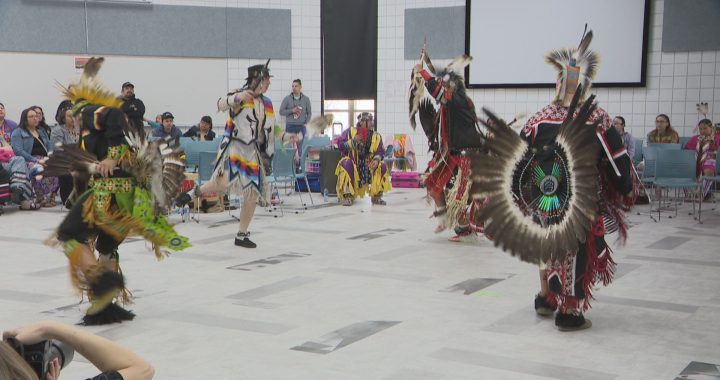Kent Driscoll
APTN National News
CAPE DORSET, Nunavut—Annie Pootoogook’s funeral was much like her art. It was raw, real, emotional and uniquely Inuit.
Over 100 people crowded into community hall in Cape Dorset, Nunavut, Wednesday afternoon to offer their grief-stricken final goodbyes to the Inuit artist who gained international acclaim for her art, but whose life ended under suspicious circumstances in Ottawa’s Rideau River in September.
The business of Cape Dorset came to a halt on this afternoon, government offices and shops shut their doors and storefronts to allow all community members to attend the funeral.
Pootoogook’s body lay in a simple pine box on an elevated folding table at the front of the main room with tie-dyed fish painted by local youth covering the ceiling and walls. Family and friends placed plastic flowers atop the closed casket throughout the service which was punctuated by the sounds of grief.
Inuit funerals are emotional and cathartic, part church service, part community grieving. All throughout the service, there were muffled sobs.
Occasionally, those sobs would turn into someone wailing loudly. Others would join in, their grief raw and open, until the sound of wailing and crying echoed off the walls of the small community hall. One family member, who tried to address the crowd, was seized by sudden sadness and could only say, “Oh my God,” before dissolving into hard tears.
To read more about Annie Pootoogook’s case click here
Pootoogook was found dead in the Rideau River on Sept. 19. Ottawa police are treating her death as suspicious and the investigation is ongoing. The Coroner’s office released Pootoogook’s body last Wednesday following a final examination by a pathologist.
Pootoogook’s home of Cape Dorset—which sits about an hour’s flight west from Iqaluit—prides itself on their traditional culture, and is the most famous locale for Inuit art.
The entire service was conducted in Inuktitut. A unilingual English speaker would recognize the hymns, just not the words.
Pootoogook’s youngest daughter Napachie, 4, attended the service. Her adoptive parents brought her to Cape Dorset for the funeral, and the little girl found out just how large her birth family is.
The only part of the service conducted in English was when Pootoogook’s family thanked the adoptive family for bringing the girl and asked everyone related to Napachie to stand so the adoptive parents could learn who they were.
The entire first two rows stood.
All through the service, the little girl was handed from one extended family member to another. Each time, the tears stopped long enough for her family to adore her with kisses and hugs.
In Inuit culture, most adoptions are open, the adoptee knows who their birth family is and maintains a connection. For her extended family, she was just the little family member they hadn’t met yet.
During the last hymn, members of Pootoogook’s family came forward to touch the casket and offer one final goodbye. Twice, men overcome with grief placed their heads on the casket, sobbing hard enough you could see them shaking from rows away.
Following the service, the pine casket was carried to a waiting Cape Dorset municipal pick-up truck. Family members piled into the back and continued to the cemetery, where Pootoogook was laid to rest.
“She always told a true story. Good or bad, it was always a true story,” said Pootoogook’s brother Cee Pootoogook.
Annie Pootoogook’s funeral was like her art in that it was full of true grief, true emotion, and told a true story.
@KentDriscoll









